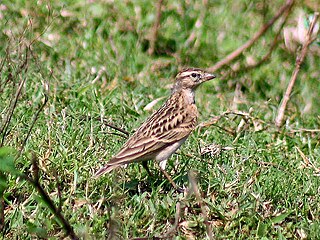
The Eurasian skylark is a passerine bird in the lark family, Alaudidae. It is a widespread species found across Europe and the Palearctic with introduced populations in Australia, New Zealand and on the Hawaiian Islands. It is a bird of open farmland and heath, known for the song of the male, which is delivered in hovering flight from heights of 50 to 100 metres. The sexes are alike. It is streaked greyish-brown above and on the breast and has a buff-white belly.

The crested lark is a species of lark widespread across Eurasia and northern Africa. It is a non-migratory bird, but can occasionally be found as a vagrant in Great Britain.

The greater short-toed lark is a small passerine bird. The current scientific name is from Ancient Greek. The genus name, Calandrella, is a diminutive of kalandros, the calandra lark, and brachydactila is from brakhus, "short", and daktulos, "toe".
Short-toed lark refers to a number of species of lark:

The Mediterraneanshort-toed lark is a small passerine bird found in and around the Mediterranean Basin. It is a common bird with a very wide range from Canary Islands north to the Iberian Peninsula and east throughout North Africa to parts of the Middle East. The International Union for Conservation of Nature has rated its conservation status as being of "least concern".

Alauda is a genus of larks found across much of Europe, Asia and in the mountains of north Africa, and one of the species endemic to the islet of Raso in the Cape Verde Islands. Further, at least two additional species are known from the fossil record. The current genus name is from Latin alauda, "lark". Pliny the Elder thought the word was originally of Celtic origin.

The singing bush lark or Horsfield's bush lark is a species of lark which inhabits grassland throughout most of Australia and much of Southeast Asia. It was described by the American naturalist Thomas Horsfield.

The red-capped lark is a small passerine bird that breeds in the highlands of eastern Africa southwards from Ethiopia and Somaliland. In the south, its range stretches across the continent to Angola and south to the Cape in South Africa.

The sand lark is a small passerine bird in the lark family, Alaudidae, found in southern Asia. It is somewhat similar to, but smaller than the short-toed larks.

Spizocorys is a genus of African larks in the family Alaudidae found in southern and eastern Africa.

Hume's short-toed lark is a species of lark in the family Alaudidae. It is found in south-central Asia from Iran and Kazakhstan to China.

Calandrella is a genus of larks in the family Alaudidae.

The Somali short-toed lark is a small passerine bird of the lark family found in eastern and north-eastern Africa.

Blanford's lark or Blanford's short-toed lark is a small passerine bird of the lark family, Alaudidae, which is native to north-eastern Africa. Its common name commemorates the English zoologist William Thomas Blanford.
The Athi short-toed lark is a species of lark in the family Alaudidae. It is found in southern Kenya and northern Tanzania.

Alaudala is a genus of lark in the family Alaudidae. The genus name is a diminutive of Alauda.

The Mongolian short-toed lark or Sykes's short-toed lark is a species of lark in the family Alaudidae. It breeds in China and Mongolia and winters in southern Asia.
Eastern short-toed lark may refer to:

The Turkestan short-toed lark is a species of lark in the family Alaudidae. It is found in Ukraine and central Turkey through parts of Central Asia and southern Siberia west to south-central Mongolia and south to southern Afghanistan. This species and the Mediterranean short-toed lark were formerly considered conspecific and called the lesser short-toed lark, but a 2020 study recovered them as distinct species.















